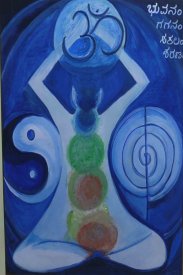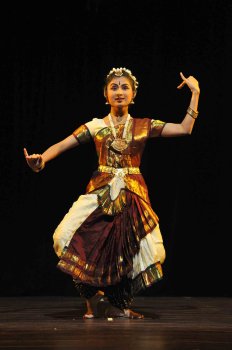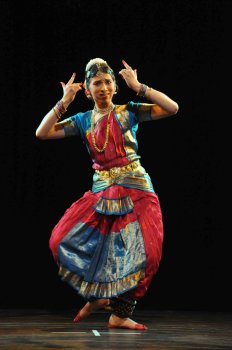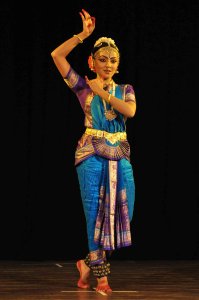
|   |

|   |
Sai Nrithyotsava 42 - Chittaranjan Mothikhane e-mail: chittaranjanmothikhane@gmail.com Photos: Dasharath November 21, 2012 Tucked amidst the Vishnudharmottara Purana is Chitra Sutra, a treatise on art. A king, who desired to cast an idol fit to be worshiped in the temple he wished to build, was advised to learn the art of painting before he was instructed in the technique of casting. On his willingness to learn, he was advised to learn the art of drawing before he ventured into painting and the art of dance before drawing and the art of music before he knew dance and the art of poetry before he knew how to sing. Thus in order to create a divine entity in the form of an idol fit for public worship, Chitra Sutra advised mastery over other arts too. 
Painting by Shobha Devi Guruprasad
Sai Nrithyotsava 42 seemed to have been inspired by the above story and introduced the audience to two more art forms. Music and painting before the dance art took over the stage. Shobha Devi Guruprasad, who had no academic training in painting, let her heart direct the hands to spread the colors on canvas to unfold the thoughts of the mind. Kannada literary works and the opening lines of popular songs from Kannada movies gave her subject to create. One common feature in all the frames was women of strength, women who preserved tradition and social values and women who made tremendous impact on society. Her over 25 canvas creations were displayed in the corridors of the venue, Seva Sadan, Bangalore on the 1st of November 2012. The audience warmed up to Carnatic classical music rendered by disciples of Sandhya Udyavar. The selection of songs varied from ode to Ganesha to Pillari Geete of Sri Purundara Dasa to composition on Parvathi by Muthaiah Bhagavatar to Krishnashtakam and concluding with a patriotic number to celebrate the Kannada Rajyotsava. Lisuriya, Swathi, Bhumika, Smruthi, Smruthi R, Sneha, Dwithi, Divyashree, Prashanth and Shashank’s rendition was simple, melodious, unpretentious and bereft of technical gimmicks for all the singers were children.
Nikhila Lokesh, disciple of Sanjay Shantaram, performed Bharatanatyam to two Kannada compositions and a padam in Tamil. One was Kalyani raga-adi tala based Padmacharan’s obeisance to Sharada through his composition “Shrunga puradheeshwari Sharade” and the other Purandara Dasa’s kriti “Rangitandeera” in Nadanamakriya and adi tala. Nikhila concluded with a padam “Chendru varuven” expressing the pangs and anger because of separation from her beloved in the khandita nayika swabhava.  Nikhila Lokesh  Aditi Boratkar Aditi Boratkar of Nagpur, disciple of Shreemathi Madkholkar, chose to celebrate the unification day of Karnataka through her selection of Kannada compositions rendered in Bharatanatyam idiom. Aditi’s invocatory number on Lord Nataraja was based on the Ranga Geete drawn from the portals of Kannada theaters. The laudatory number was set to raga Latangi - adi tala. Chikkadevaraya Wodeyar’s raga Bouli tala rupaka based composition describing Yashoda’s attempt to wake little Krishna up was her second dance and she concluded with a tillana in raga Sunadavinodhini-adi tala which had Purandara Dasa’s lyrics interspersed.  Priyanka L Achar Mysore B Nagaraj presented his disciples Pavan Kumar, Nidhag Karunad, Karthik Shetty, Shweta Venkatesh, Kavyashree Nagaraj, Kavita Krishnamurthy, Anusha Udupa and Renuka in a dance feature based on Kathak. The advantage of Kannada language adapting well to Hindustani music was fully explored through the vachanas of 12th century Veerashaivas. The compositions filled with bhakti and moral was embellished with code of conduct. The belief of God being omnipresent and omnipotent and beyond form was also conveyed through selected sacred vachanas strung together to form this feature. Basaveshwara and Allamaprabhu’s complex philosophy was effectively translated through dance that touched the hearts of the audience. The pearls of wisdom were compositions Neerige naidileye shungara, Chakorange chandramana chinte, Neleda mareya nidhanadante, Bhoomi ninnadalla, Nada priya nembaru, Ettetta nodidaratataa and Patalavittitta sripadavatatta. The presentation was full-fledged bhakti.
Priyanka L Achar, disciple of Sushma Mohan and Pulikeshi Kasturi, used the entire slot to render a varnam in Bharatanatyam. Priyanka gave the audience a fleeting glimpse of the episode where Krishna vanquishes Kamsa and another where he protects the honor of Draupadi. The music was set to raga Sumanasaranjini. While Kannadigas celebrated the day of unification of the Kannada State, Sai Nrithyotsava 42 within the sacred space of an auditorium celebrated the same occasion befittingly through painting, music and, of course, dance. |